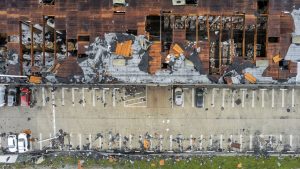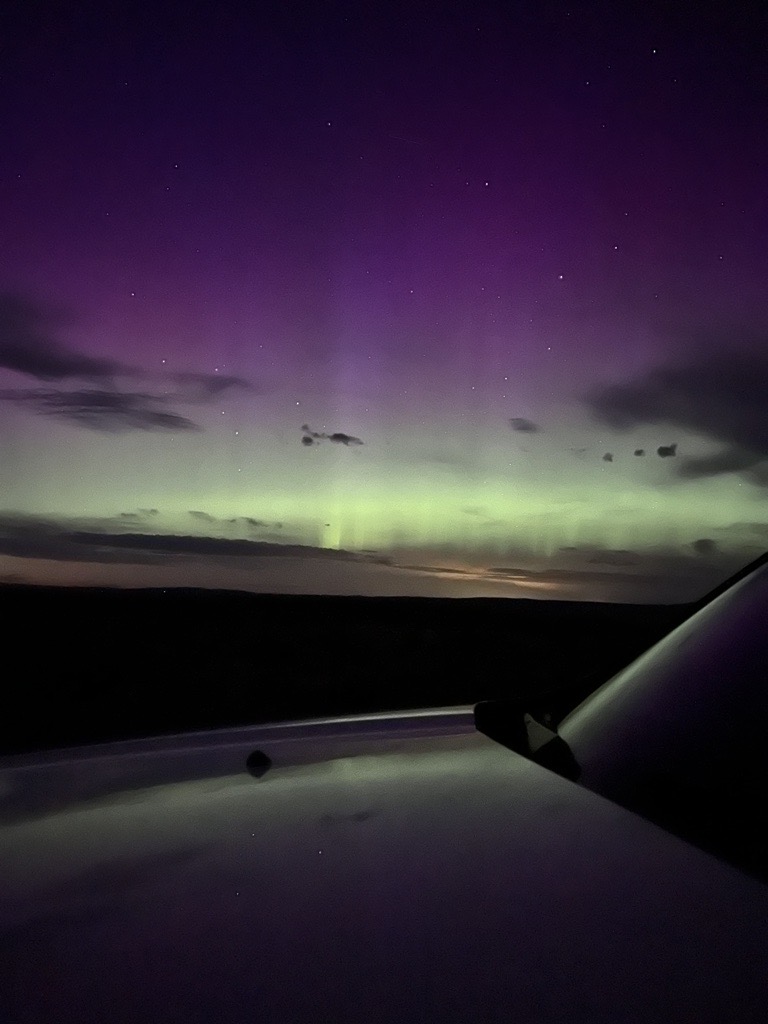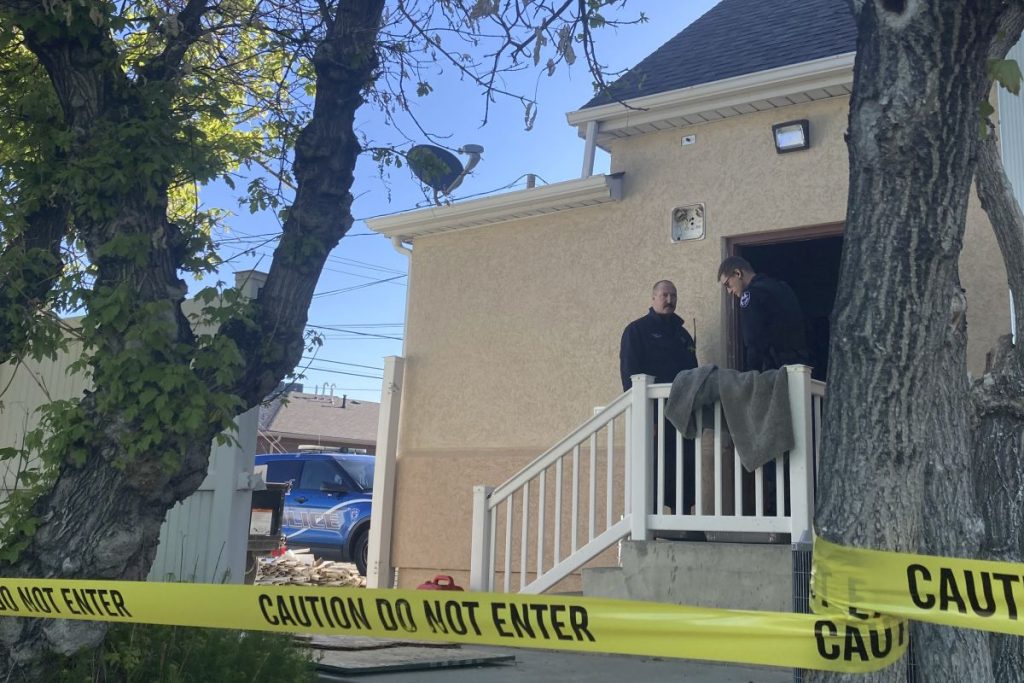Possible Tornado Near Los Angeles Rips Up Building Roofs
Written by Associated Press on March 22, 2023
Possible tornado near Los Angeles rips up building roofs
By JOHN ANTCZAK and CHRISTOPHER WEBER Associated Press
LOS ANGELES (AP) — A possible tornado touched down in a Los Angeles suburb on Wednesday, ripping pieces of roofing off a line of commercial buildings and sending the debris twisting into the sky and across a city block, injuring one person.

Damage to a building is seen on Wednesday, March 22, 2023 in Montebello, Calif., after a possible tornado. (AP Photo/Ringo H.W. Chiu)
The National Weather Service said it sent teams to assess damage in Montebello and the southern Santa Barbara County city of Carpinteria, where it confirmed that a tornado hit a mobile home park on Tuesday, with wind gusts of up to 75 miles (120 kilometers) per hour that damaged about 25 homes.
According to preliminary information, it’s “very possible” that the apparent funnel cloud spotted a few miles southeast of downtown Los Angeles was a tornado, said meteorologist Rose Schoenfeld with the weather service.
“It’s definitely not something that’s common for the region,” Schoenfeld said.
One person was injured and was taken to a hospital in Montebello, said Alex Gillman, a city spokesman. He didn’t know the severity of the injury.
Michael Turner could hear the winds get stronger from inside his office at the 33,000-square-foot (3,065-square-meter) warehouse he owns just south of downtown Montebello. When the lights started flickering, he went outside to find his employees gazing up at the ominous sky. He brought everyone inside.
“It got very loud. Things were flying all over the place,” Turner said. “The whole factory became a big dustbowl for a minute. Then when the dust settled, the place was just a mess.”
Nobody was hurt, but the gas line was severed, fire sprinklers broke, all the skylights shattered and a 5,000-square-foot (465-square-meter) section of roof was “just gone,” Turner said. He said his polyester fiber business, Turner Fiberfill, could be closed for months.
“I’ve been in California since 1965. Never seen anything like this,” Turner said. “Earthquakes — we’re used to that.”
At least five structures and a small number of vehicles were damaged, but a full assessment was still underway, Gillman said. Damage spread over more than one city block but the extent of the perimeter was still being determined. Gas and power to the area has been shut off, he said.
The rare and violent weather came amid a strong late-season Pacific storm that brought damaging winds and more rain and snow to saturated California. Two people died Tuesday as the storm raked the San Francisco Bay Area with powerful gusts and downpours. An on-duty San Francisco police sergeant was hospitalized with life threatening injuries after a tree fell on him Tuesday, the department said.
Schoenfeld said more unstable weather was possible through the afternoon in Southern California.
“All the ingredients are there for more possible events like the one we saw earlier,” she said.
The last time the weather service’s Los Angeles office sent out tornado assessment teams was 2016 near Fillmore in Ventura County, where it was determined that a small twister had touched down, Schoenfeld said.
A tornado warning based on radar also was issued Tuesday night for the Point Mugu area west of Malibu. The warning was later canceled and the Ventura County Sheriff’s Office tweeted there was no evidence a tornado touched down.
The storm was tapering off in California from north to south while pushing inland across the Southwest, the Four Corners region and the central and southern Rockies, the National Weather Service said. On Tuesday, some residents of north-central Arizona were told to prepare to evacuate because of rising water levels in rivers and basins.
The wind and rain mayhem from San Francisco Bay south to Monterey Bay on Tuesday was caused by an extraordinary drop in barometric pressure over the eastern Pacific that meteorologists described as “explosive cyclogenesis.”
“Wow. Even by the standards of what has turned out to be one of our most extraordinary winter seasons in a very long time, yesterday … stands out,” the Bay Area weather office wrote.
Trees and power lines were blown down. Windows were blown out from two San Francisco high-rises, NBC Bay Area reported. Ferry service was disrupted because conditions were too rough. Three barges got loose and damaged a bridge.
An Amtrak commuter train carrying 55 passengers struck a downed tree and derailed near the East Bay village of Porta Costa. The train remained upright and nobody was injured, Amtrak and fire officials said.
Five deaths were attributed to the storm. In the Bay Area community of Portola Valley, a man driving a sewer truck was killed when a tree fell onto the vehicle, the California Highway Patrol said. And in the community of Rossmoor, a driver was injured and a passenger died after a large tree fell onto a car, the Contra Costa County Fire Protection District said.
In Oakland, a man inside a tent died Tuesday night after a tree fell on it near Lake Merritt.
Two people also died at Zuckerberg San Francisco General Hospital on Tuesday while receiving treatment for injuries suffered in separate storm-related incidents, according to city officials.
In the Monterey Bay region, Santa Cruz County was blasted with gusts up to 80 mph (129 kph) at midday. Along the coastline of the Monterey Bay National Marine Sanctuary, ocean foam blew across the roadways like large snowflakes.
Wind gusts reached 76 mph (122 kph) in Santa Cruz mountain communities, including Boulder Creek.
Resident Frank Kuhr waited for hours Tuesday afternoon at a downtown supermarket for crews to remove large redwoods that blocked a highway. “Trees are down everywhere,” Kuhr said. “The wind has been unbelievable. Branches were flying through the air, and folks could hear trees just falling and cracking.”
“This one’s a doozy,” Kuhr said.
The 1.4 inch (3.5 centimeters) of rain that fell on downtown Los Angeles broke the March 21 record of 1.34 inches (3.40 centimeters) set in 1893.
Some 121,000 customers were without electricity early Wednesday throughout the state, according to PowerOutage.us.
The National Weather Service said Tuesday’s storm, which came on the first full day of spring following the state’s extraordinary winter, was a Pacific low pressure system interacting with California’s 12th atmospheric river since late December.
California’s unexpected siege of wet weather after years of drought also included February blizzards powered by arctic air.
The storms have unleashed flooding and loaded mountains with so much snow that roofs have been crushed and crews have struggled to keep highways clear of avalanches.
The Mammoth Mountain resort in the eastern Sierra Nevada announced that it will remain open for skiing and snowboarding at least through the end of July.
With a season-to-date snowfall of 634 inches (16.1 meters) at the main lodge, it was likely just one storm away from breaking the all-time record of 668 inches (16.9 meters) set in the 2010-2011 season.




